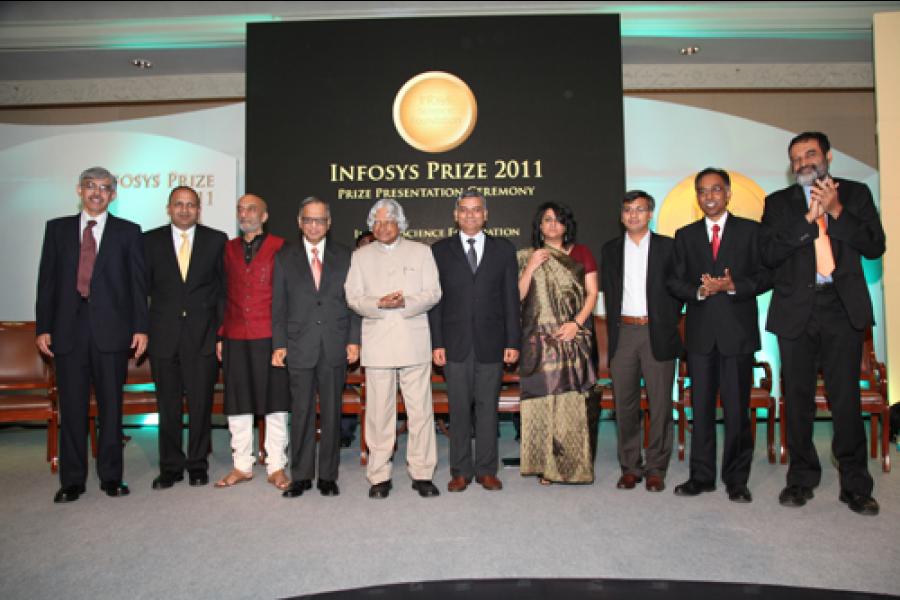In Restoring Romance to Research, Infosys is still the Bellwether
By now it’s common understanding that countries that took huge bets on research, not only to advance their knowledge stock but gain competitive advantage, have reaped great rewards. A notable example is the United States. Author Thomas Friedman says public funded research is the one of the five pillars ofAmerica’s success. Watching all the Infosys Prize winners receive the Prize last evening, it seemed Infosys took a big bet three years ago when it set up the Infosys Science Foundation and instituted prizes in five categories. One more category, humanities, is being added next year. And if the applauses, solemn thank-you speeches (of the recipients) and the celebratory mood of the audience is any indication, the bet has begun paying off.
The idea is to lift the image of basic research and the sciences, says Pradeep Khosla, dean of engineering at Carnegie Mellon University and the jury chair for the category of engineering and computer science. “It might not reach all the 1.2 billion people inIndia, but even if 1000 students get inspired to pursue a career in this, it’s an achievement,” he says.
You may read about the winners and their work, along with their stories in cartoons here. But I can warn you, that’d still be a mouthful. So let me share some brief descriptions that each category jury said about their winners while explaining their work.
The most difficult first: mathematics. Stanford’s analytic number theorist, Kannan Soundarajan’s contribution to mathematics is in the league of S. Ramanujan, G H Hardy (popularly known in India as the man who invited and escorted Ramanujan to Cambridge, UK), and John Littlewood. As for the explanation, if the jury chair, Prof Srinivasa S Varadhan of NYU found “it difficult to explain Soundarajan’s work in short,” I’d not even attempt an explanation here, except that many of the analytic and combinatorial tools he helped develop have become standard tools for the researchers in the field.
Raghuram Rajan and Pratap Bhanu Mehta’s work (in economics and social sciences respectively) we are all familiar with, prolific columnists as these winners are. Rajan, a “devoted teacher”, couldn’t be present at the ceremony because he “had to teach for nine hours” soon after he addressed everyone inBangalorethrough video conference fromChicago. He raised a valid issue in his short address: “Such prizes have tremendous value forIndiawhich not only needs new ideas in science and engineering but also in social sciences to ensure we have the kind of society we want.”
In engineering, Kalyanmoy Deb’s work can most simply be described as computationally efficient algorithms that design or optimize the design of various artifacts. They have even been used in commercial optimization software such as iSight and VisualDoc. And as jury chair Khosla said, “Deb even wrote the software but gave away free. So he didn’t make a lot of money.”
I think there are still researchers out there who think of the greater good first, monetization later, as they push the boundaries. One such example is Imran Siddiqi’s work. Winner in the life sciences category, his work shows the elegant use of genetics and molecular biology. In simple words, he’s cracked a long-standing issue in plant biology: Hybrid seeds lose their ‘vigour’, so farmers have no choice but to buy fresh seeds for every cropping season. That happens because there is a “genetic material reshuffling” that leads to separation of traits in the seeds. Siddiqi and his collaborators have found some genes and understood the molecular mechanism by which this separation happens. Eventually this would lead to making hybrid seeds into “clonal seeds” where the next-generation seed is identical to its parents. Think cheaper seeds, with shorter production cycles.
A disruptive technology indeed, whenever it reaches the market. Given the rate of knowledge generation in this field, it’s not more than 10 years away. But won’t that rattle big seed companies? “The consensus in the scientific community, which is about 15 groups worldwide, is that most of this work is now in the public domain and that it should remain so. That would not only help in licensing but even prevent seed companies’ monopoly,” says Siddiqi.
To be sure other foundations in India, Premji and Bharti included, are doing commendable work. But by glamorizing research, Infosys has begun a good tradition as social returns of research are higher than private returns that we often calculate.
Time for many more such initiatives by other companies inIndia? As Indian Institute of Science director P Balaram often says, “companies, especially those that make a large amount of money” should fund research as a public responsibility.
The thoughts and opinions shared here are of the author.
Check out our end of season subscription discounts with a Moneycontrol pro subscription absolutely free. Use code EOSO2021. Click here for details.

